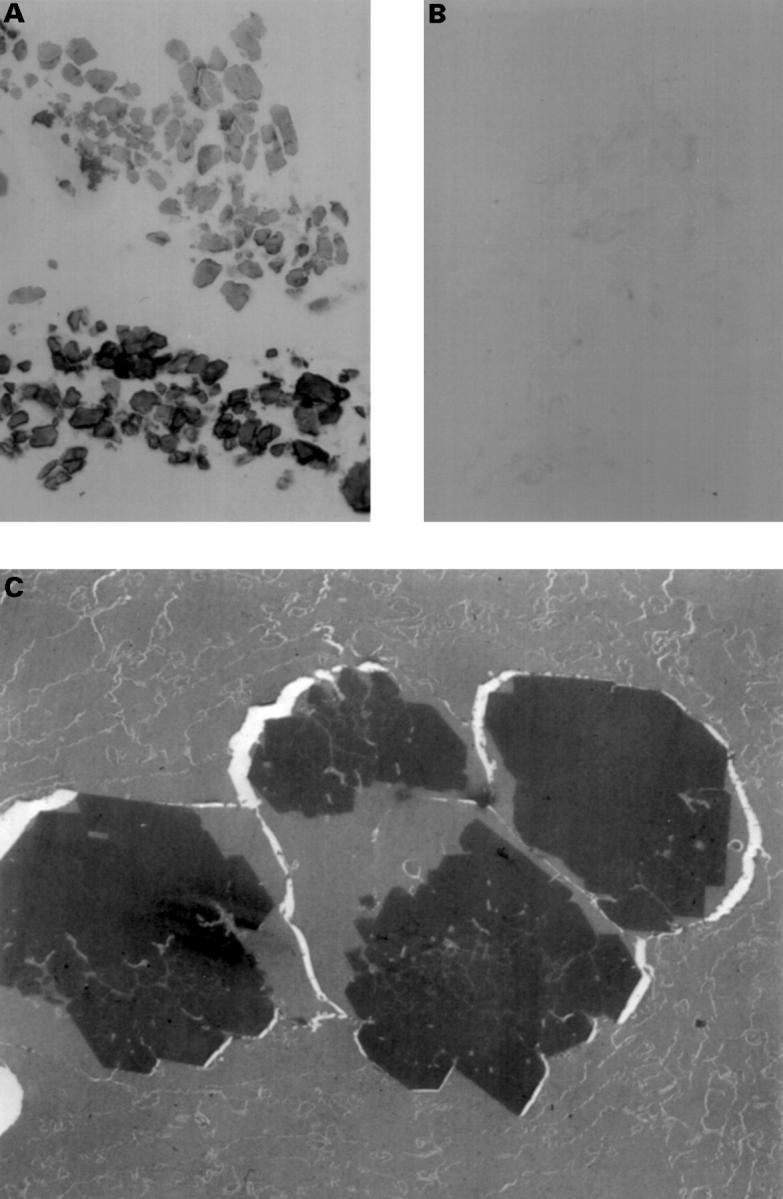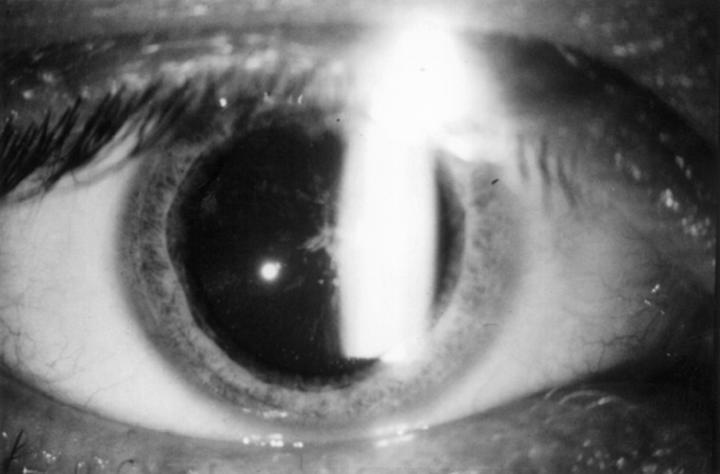Abstract
BACKGROUND/AIM—Hereditary hyperferritinaemia cataract syndrome (HHCS) is an autosomal dominant disorder characterised by elevated serum L-ferritin and bilateral cataracts. The ocular manifestations of this disorder are poorly studied. This study therefore sought to determine the origin of cataracts in HHCS. METHODS—L-ferritin ELISA, immunohistochemical and ultrastructural analysis of a lens nucleus from an HHCS individual. RESULTS—The HHCS lens L-ferritin content was 147 µg/g dry weight of lens compared with <16 µg/g for a non-HHCS control cataract lens. The cataract comprised discrete crystalline inclusions with positive staining with anti-L-ferritin but not anti-H-ferritin. CONCLUSIONS—This unusual finding of crystalline opacities in the lens may be unique to HHCS and is likely to result from disturbed metabolism of L-ferritin within the lens or an abnormal interaction between L-ferritin and lens proteins.
Full Text
The Full Text of this article is available as a PDF (139.5 KB).
Figure 1 .
Slit lamp appearance of the lens from the proband. The cataract is visible as a central sutural opacity within the lens with additional cortical opacities visible extending radially. In the adults, the cortical opacities were more prominent near the lens equator but extending axially with increasing age. No other ocular abnormalities were demonstrated. The sequence of sutural opacities followed by radiating cortical opacity was reminiscent of the appearance of cataracts developing in diabetic rats.8
Figure 2 .

(A) Light microscopic appearance of crystalline inclusions within the lens stroma showing dense staining with monoclonal anti-L-ferritin (×400). Staining was absent from the lens stroma itself. (B) The deposits were not stained with anti-H-ferritin (×400). (C) Appearance of inclusions at ×50 000 magnification showing square-shaped crystal morphology. The crystals were not associated with any cellular elements, but appeared to lie free within the stroma.
Selected References
These references are in PubMed. This may not be the complete list of references from this article.
- Arnold J. D., Mumford A. D., Lindsay J. O., Hegde U., Hagan M., Hawkins J. R. Hyperferritinaemia in the absence of iron overload. Gut. 1997 Sep;41(3):408–410. doi: 10.1136/gut.41.3.408. [DOI] [PMC free article] [PubMed] [Google Scholar]
- Beaumont C., Leneuve P., Devaux I., Scoazec J. Y., Berthier M., Loiseau M. N., Grandchamp B., Bonneau D. Mutation in the iron responsive element of the L ferritin mRNA in a family with dominant hyperferritinaemia and cataract. Nat Genet. 1995 Dec;11(4):444–446. doi: 10.1038/ng1295-444. [DOI] [PubMed] [Google Scholar]
- Blakytny R., Harding J. J. Prevention of cataract in diabetic rats by aspirin, paracetamol (acetaminophen) and ibuprofen. Exp Eye Res. 1992 Apr;54(4):509–518. doi: 10.1016/0014-4835(92)90129-g. [DOI] [PubMed] [Google Scholar]
- Carrell R. W., Lomas D. A. Conformational disease. Lancet. 1997 Jul 12;350(9071):134–138. doi: 10.1016/S0140-6736(97)02073-4. [DOI] [PubMed] [Google Scholar]
- Cazzola M., Bergamaschi G., Tonon L., Arbustini E., Grasso M., Vercesi E., Barosi G., Bianchi P. E., Cairo G., Arosio P. Hereditary hyperferritinemia-cataract syndrome: relationship between phenotypes and specific mutations in the iron-responsive element of ferritin light-chain mRNA. Blood. 1997 Jul 15;90(2):814–821. [PubMed] [Google Scholar]
- Girelli D., Corrocher R., Bisceglia L., Olivieri O., De Franceschi L., Zelante L., Gasparini P. Molecular basis for the recently described hereditary hyperferritinemia-cataract syndrome: a mutation in the iron-responsive element of ferritin L-subunit gene (the "Verona mutation") Blood. 1995 Dec 1;86(11):4050–4053. [PubMed] [Google Scholar]
- Goralska M., Harned J., Fleisher L. N., McGahan M. C. The effect of ascorbic acid and ferric ammonium citrate on iron uptake and storage in lens epithelial cells. Exp Eye Res. 1998 Jun;66(6):687–697. doi: 10.1006/exer.1997.0466. [DOI] [PubMed] [Google Scholar]
- Haley D. A., Horwitz J., Stewart P. L. The small heat-shock protein, alphaB-crystallin, has a variable quaternary structure. J Mol Biol. 1998 Mar 20;277(1):27–35. doi: 10.1006/jmbi.1997.1611. [DOI] [PubMed] [Google Scholar]
- Harding J. J. Cataract, Alzheimer's disease, and other conformational diseases. Curr Opin Ophthalmol. 1998 Feb;9(1):10–13. doi: 10.1097/00055735-199802000-00003. [DOI] [PubMed] [Google Scholar]
- Hook D. W., Harding J. J. Protection of enzymes by alpha-crystallin acting as a molecular chaperone. Int J Biol Macromol. 1998 May-Jun;22(3-4):295–306. doi: 10.1016/s0141-8130(98)00027-0. [DOI] [PubMed] [Google Scholar]
- Horwitz J. Alpha-crystallin can function as a molecular chaperone. Proc Natl Acad Sci U S A. 1992 Nov 1;89(21):10449–10453. doi: 10.1073/pnas.89.21.10449. [DOI] [PMC free article] [PubMed] [Google Scholar]
- Levi S., Girelli D., Perrone F., Pasti M., Beaumont C., Corrocher R., Albertini A., Arosio P. Analysis of ferritins in lymphoblastoid cell lines and in the lens of subjects with hereditary hyperferritinemia-cataract syndrome. Blood. 1998 Jun 1;91(11):4180–4187. [PubMed] [Google Scholar]
- McGahan M. C., Harned J., Grimes A. M., Fleisher L. N. Regulation of ferritin levels in cultured lens epithelial cells. Exp Eye Res. 1994 Nov;59(5):551–555. doi: 10.1006/exer.1994.1140. [DOI] [PubMed] [Google Scholar]
- Mumford A. D., Vulliamy T., Lindsay J., Watson A. Hereditary hyperferritinemia-cataract syndrome: two novel mutations in the L-ferritin iron-responsive element. Blood. 1998 Jan 1;91(1):367–368. [PubMed] [Google Scholar]
- Ponka P., Beaumont C., Richardson D. R. Function and regulation of transferrin and ferritin. Semin Hematol. 1998 Jan;35(1):35–54. [PubMed] [Google Scholar]
- Worwood M. Ferritin in human tissues and serum. Clin Haematol. 1982 Jun;11(2):275–307. [PubMed] [Google Scholar]



